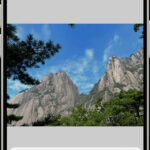Need to shrink your iPhone photos? Whether you’re running low on storage or want to share pictures faster, this guide reveals the best ways to compress photos on your iPhone. We’ve tested various methods, from built-in iOS features to third-party apps, to bring you the most effective solutions. Learn how to reduce image file size without sacrificing quality!
5 Proven Methods to Compress iPhone Photos
Here are five reliable ways to compress pictures on your iPhone:
1. Leverage iPhone’s Built-in Editing Tools
Your iPhone has hidden compression capabilities within the Photos app.
- Open the Photos app and select the image.
- Tap “Edit,” then select the crop tool.
- Make adjustments (even slight ones) and tap “Done.” Cropping subtly reduces file size.
This method offers a simple way to shrink images while preserving reasonable quality.
2. Explore Third-Party Compression Apps
For more advanced compression, try these apps from the App Store:
- Compress Photos & Pictures: Offers various compression levels.
- Image Compressor: Reduces file size while maintaining quality.
- TinyPNG: Specializes in compressing PNG and JPEG images.
Always check user reviews and app permissions before downloading.
3. Utilize Online Image Compression Services
Compress photos without installing apps using these online tools:
- TinyPNG: Excellent for PNG and JPEG compression.
- Compress JPEG: Specifically designed for JPEG images.
Remember to use secure internet connections when uploading sensitive images.
4. Convert Photos to HEIC Format
Converting images to the HEIC format significantly reduces file size without major quality loss. A 5MB JPEG can become a 2MB HEIC while looking virtually identical.
Download a photo converter app from the App Store. Recommended options include:
- HEIC Converter: Converts images to and from HEIC format.
- Image Converter: Supports various image formats, including HEIC.
5. The Screenshot Hack: Quick and Dirty Compression
For a fast, albeit less precise, compression method:
- Open the photo in full-screen mode.
- Take a screenshot (Power + Volume Up buttons).
- Crop the screenshot to remove unnecessary borders.
This reduces file size drastically but sacrifices some image quality.
Smart Alternatives to Compression
Beyond direct compression, consider these strategies:
1. Convert Live Photos to Still Images
Live Photos consume significant storage. Convert them to still images using the free Clever Cleaner app:
- Download Clever Cleaner from the App Store.
- Launch the app and select “Lives.”
- Choose the Live Photos to convert and tap “Compress.”
2. Optimize Your Camera Settings
Prevent large photo files by adjusting your camera settings:
- Lower the Resolution: Capture smaller images by default.
- Use High Efficiency Formats (HEIF/HEVC): Enable these in Settings > Camera > Formats.
3. Use iCloud Photo Optimization
iCloud can store full-resolution photos while keeping optimized versions on your iPhone:
- Enable Optimize iPhone Storage in Settings > Photos.
4. Regularly Clean Up Your Photo Library
Delete duplicate or unwanted photos to free up space:
- Manually delete photos or use an app like Clever Cleaner.
Final Thoughts: Beyond Compression
If you constantly struggle with storage, explore our guides on organizing photos and clearing photo storage on our website. Join the conversation on the InsanelyMac iPhone Forum for more tips and advice.
FAQ: Your Compression Questions Answered
Can I batch compress photos? Yes, many third-party apps offer batch compression.
What settings balance quality and file size? Aim for minimal quality loss. Lossy compression (JPEG, HEIC) offers good balance. Lossless (PNG, RAW) preserves all data.
Does iCloud Photo Optimization compress images? No, it stores full-resolution images in iCloud and optimized versions on your device.
What happens to EXIF data? Compression might remove EXIF data. Some apps offer preservation options.
Can I compress photos in the Files app? No, you need third-party apps or Photos app features.
Can I undo compression? Not easily, unless you have a backup of the original.
Does switching to HEIC convert existing photos? No, only new photos will be in HEIC format.
